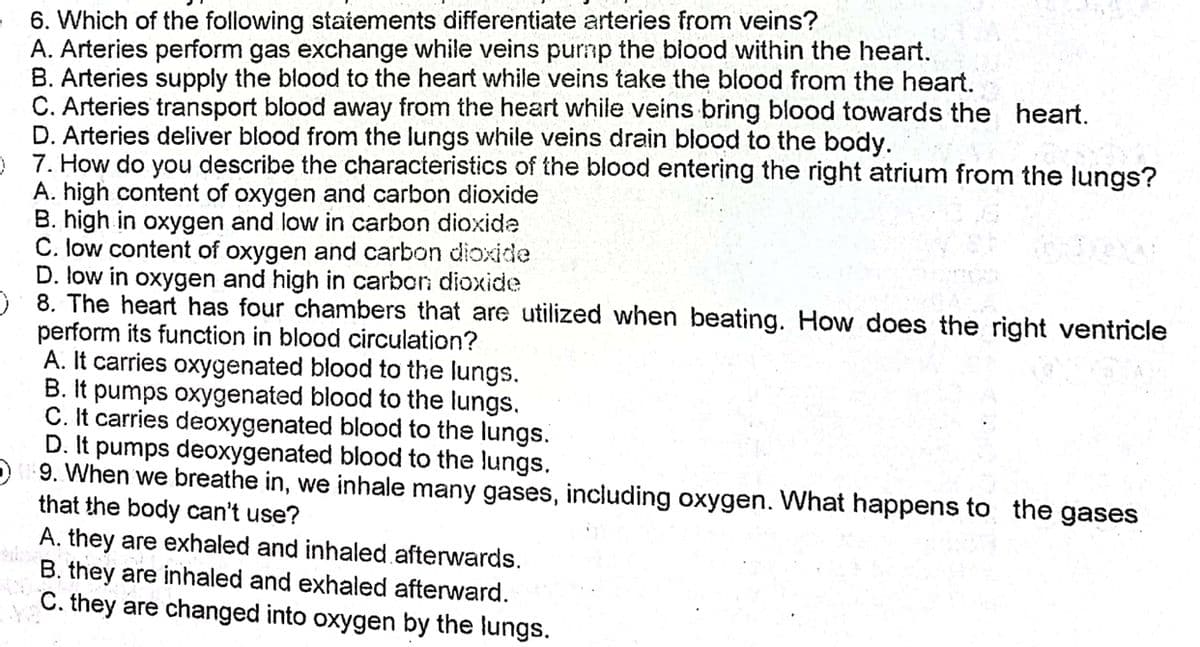6. Which of the following staiements differentiate arteries from veins? A. Arteries perform gas exchange while veins purnp the blood within the heart. B. Arteries supply the blood to the heart while veins take the blood from the heart. C. Arteries transport blood away from the heart while veins bring blood towards the heart. D. Arteries deliver blood from the lungs while veins drain blood to the body. O 7. How do you describe the characteristics of the blood entering the right atrium from the lungs? A. high content of oxygen and carbon dioxide B. high in oxygen and low in carbon dioxide C. low content of oxygen and carbon dioxide D. low in oxygen and high in carborn dioxide D8. The heart has four chambers that are utilized when beating. How does the right ventricle perform its function in blood circulation? A. It carries oxygenated blood to the lungs. B. It pumps oxygenated blood to the lungs. C. It carries deoxygenated blood to the lungs. D. It pumps deoxygenated blood to the lungs. 9. When we breathe in, we inhale many gases, including oxygen. What happens to the gases that the body can't use? A. they are exhaled and inhaled.afterwards. B. they are inhaled and exhaled afterward. C. they are changed into oxygen by the lungs.
6. Which of the following staiements differentiate arteries from veins? A. Arteries perform gas exchange while veins purnp the blood within the heart. B. Arteries supply the blood to the heart while veins take the blood from the heart. C. Arteries transport blood away from the heart while veins bring blood towards the heart. D. Arteries deliver blood from the lungs while veins drain blood to the body. O 7. How do you describe the characteristics of the blood entering the right atrium from the lungs? A. high content of oxygen and carbon dioxide B. high in oxygen and low in carbon dioxide C. low content of oxygen and carbon dioxide D. low in oxygen and high in carborn dioxide D8. The heart has four chambers that are utilized when beating. How does the right ventricle perform its function in blood circulation? A. It carries oxygenated blood to the lungs. B. It pumps oxygenated blood to the lungs. C. It carries deoxygenated blood to the lungs. D. It pumps deoxygenated blood to the lungs. 9. When we breathe in, we inhale many gases, including oxygen. What happens to the gases that the body can't use? A. they are exhaled and inhaled.afterwards. B. they are inhaled and exhaled afterward. C. they are changed into oxygen by the lungs.
Biology: The Dynamic Science (MindTap Course List)
4th Edition
ISBN:9781305389892
Author:Peter J. Russell, Paul E. Hertz, Beverly McMillan
Publisher:Peter J. Russell, Paul E. Hertz, Beverly McMillan
Chapter44: The Circulatory System
Section: Chapter Questions
Problem 4TYK: A characteristic of blood circulation through or to the heart is that: a. the superior vena cava...
Related questions
Question

Transcribed Image Text:6. Which of the following statements differentiate arteries from veins?
A. Arteries perform gas exchange while veins purnp the blood within the heart.
B. Arteries supply the blood to the heart while veins take the blood from the heart.
C. Arteries transport blood away from the heart while veins bring blood towards the heart.
D. Arteries deliver blood from the lungs while veins drain blood to the body.
) 7. How do you describe the characteristics of the blood entering the right atrium from the lungs?
A. high content of oxygen and carbon dioxide
B. high in oxygen and low in carbon dioxide
C. low content of oxygen and carbon dioxide
D. low in oxygen and high in carbon dioxide
O 8. The heart has four chambers that are utilized when beating. How does the right ventricle
perform its function in blood circulation?
A. It carries oxygenated blood to the lungs.
B. It pumps oxygenated blood to the lungs.
C. It carries deoxygenated blood to the lungs.
D. It pumps deoxygenated blood to the lungs.
9. When we breathe in, we inhale many gases, including oxygen. What happens to the gases
that the body can't use?
A. they are exhaled and inhaled afterwards.
B. they are inhaled and exhaled afterward.
C. they are changed into oxygen by the lungs.
Expert Solution
This question has been solved!
Explore an expertly crafted, step-by-step solution for a thorough understanding of key concepts.
This is a popular solution!
Trending now
This is a popular solution!
Step by step
Solved in 4 steps with 4 images

Knowledge Booster
Learn more about
Need a deep-dive on the concept behind this application? Look no further. Learn more about this topic, biology and related others by exploring similar questions and additional content below.Recommended textbooks for you

Biology: The Dynamic Science (MindTap Course List)
Biology
ISBN:
9781305389892
Author:
Peter J. Russell, Paul E. Hertz, Beverly McMillan
Publisher:
Cengage Learning

Anatomy & Physiology
Biology
ISBN:
9781938168130
Author:
Kelly A. Young, James A. Wise, Peter DeSaix, Dean H. Kruse, Brandon Poe, Eddie Johnson, Jody E. Johnson, Oksana Korol, J. Gordon Betts, Mark Womble
Publisher:
OpenStax College

Fundamentals of Sectional Anatomy: An Imaging App…
Biology
ISBN:
9781133960867
Author:
Denise L. Lazo
Publisher:
Cengage Learning

Biology: The Dynamic Science (MindTap Course List)
Biology
ISBN:
9781305389892
Author:
Peter J. Russell, Paul E. Hertz, Beverly McMillan
Publisher:
Cengage Learning

Anatomy & Physiology
Biology
ISBN:
9781938168130
Author:
Kelly A. Young, James A. Wise, Peter DeSaix, Dean H. Kruse, Brandon Poe, Eddie Johnson, Jody E. Johnson, Oksana Korol, J. Gordon Betts, Mark Womble
Publisher:
OpenStax College

Fundamentals of Sectional Anatomy: An Imaging App…
Biology
ISBN:
9781133960867
Author:
Denise L. Lazo
Publisher:
Cengage Learning

Cardiopulmonary Anatomy & Physiology
Biology
ISBN:
9781337794909
Author:
Des Jardins, Terry.
Publisher:
Cengage Learning,

Biology: The Unity and Diversity of Life (MindTap…
Biology
ISBN:
9781305073951
Author:
Cecie Starr, Ralph Taggart, Christine Evers, Lisa Starr
Publisher:
Cengage Learning